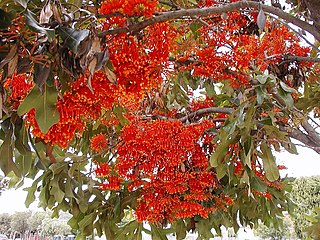
Stenocarpus is a genus of about 22 species of flowering plants in the family Proteaceae. They are trees or shrubs with variably-shaped leaves, zygomorphic, bisexual flowers, the floral tube opening on the lower side before separating into four parts, followed by fruit that is usually a narrow oblong or cylindrical follicle.

Orites excelsus, commonly known as prickly ash, mountain silky oak or white beefwood, is a species of flowering plant in the family Proteaceae and is endemic to eastern Australia. It is a medium-sized to tall rainforest tree with oblong to lance-shaped leaves, variously lobed and with teeth on the edges. The flowers are white and arranged in leaf axils in spikes that are shorter than the leaves.
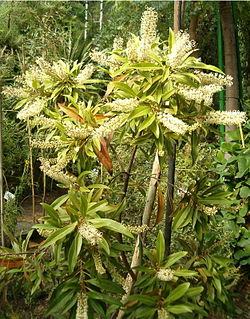
Buckinghamia is a genus of only two known species of trees, belonging to the plant family Proteaceae. They are endemic to the rainforests of the wet tropics region of north eastern Queensland, Australia. The ivory curl flower, B. celsissima, is the well known, popular and widely cultivated species in gardens and parks, in eastern and southern mainland Australia, and additionally as street trees north from about Brisbane. The second species, B. ferruginiflora, was only recently described in 1988.

Grevillea crithmifolia is a species of flowering plant in the family Proteaceae and is endemic to the south-west of Western Australia. It is a dense shrub with linear leaves, divided leaves with narrowly oblong lobes, or both, and clusters of pale pink to creamy-white flowers.
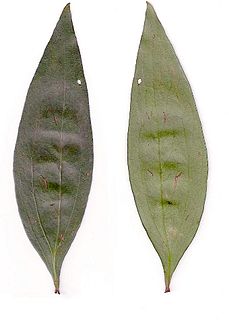
Stenocarpus salignus, known as the scrub beefwood is an Australian rainforest tree in the family Proteaceae. Found in warmer rainforests on the coast and ranges. It is often found in warm temperate rainforest on poorer sedimentary soils, or on volcanic soils above 750 metres above sea level. It was originally described by the botanist Robert Brown in 1810.
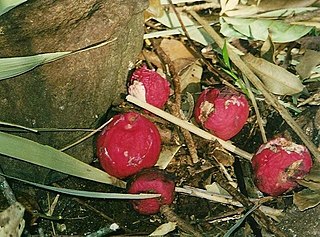
Syzygium ingens, commonly known as red apple, is a species of flowering plant that is endemic to eastern Australia. It is a medium-sized to tall rainforest tree with narrow elliptic to oblong leaves and panicles of white flowers on the ends of branchlets, followed by spherical red berries.

Stenocarpus cryptocarpus, commonly known as the giant-leaved stenocarpus, is a species of flowering plant in the family Proteaceae and is endemic to north Queensland. It is a tree with buttress roots at the base, simple, mostly elliptical adult leaves, groups of cream-coloured flowers and narrow oblong follicles.

Grevillea integrifolia, commonly known as entire-leaved grevillea, is a species of flowering plant in the family Proteaceae and is endemic to the south-west of Western Australia. It is an erect shrub with egg-shaped leaves, the narrower end towards the base, and cylindrical clusters of white to creamy-white flowers.

Grevillea althoferorum, commonly known as the split-leaved grevillea, is a species of flowering plant in the family Proteaceae and is endemic to a restricted area of Western Australia. It is a compact, rounded shrub with sharply-pointed, deeply lobed leaves and dull yellow flowers with a creamy-yellow style.

Xylomelum cunninghamianum is a species of flowering plant in the family Proteaceae and is endemic to eastern Australia. It is a shrub or small tree with narrow elliptic to lance-shaped leaves with toothed edges when young, groups of flowers covered with brownish hairs and oval fruit densely covered with velvety rust-coloured to grey hair.
Stenocarpus acacioides is a species of flowering plant in the family Proteaceae and is endemic to north-western Australia. It is a shrub or tree with elliptic leaves and groups of white flowers and woody, linear follicles.

Stenocarpus angustifolius is a species of flowering plant in the family Proteaceae and is endemic to Queensland. It is a shrub or small tree with narrow lance-shaped adult leaves, groups of creamy white flowers and cylindrical follicles.
Stenocarpus verticis is a species of flowering plant in the family Proteaceae and is endemic to northern Australia. It is a tree with elliptic or lance-shaped adult leaves and groups of cream-coloured flowers covered with woolly, rust-coloured or grey hairs.

Stenocarpus cunninghamii, commonly known as little wheel bush, is a species of flowering plant in the family Proteaceae and is endemic to northern Australia. It is a shrub or small tree with simple, narrow elliptic or lance-shaped adult leaves, groups of pale yellow or white flowers and woody, linear follicles.
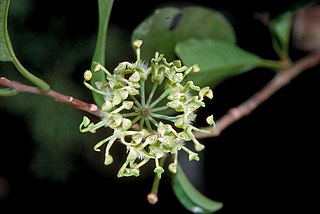
Stenocarpus reticulatus, commonly known as black silky oak, is a species of flowering plant in the family Proteaceae and is endemic to north Queensland. It is a tree with simple leaves, groups of strongly-perfumed, creamy-white flowers and flattened, semi-circular follicles.
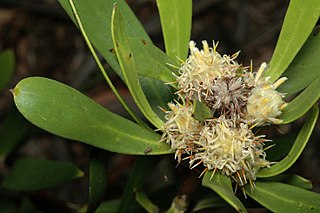
Isopogon attenuatus is a species of plant in the family Proteaceae and is endemic to the south-west of Western Australia. It is a shrub with oblong to spatula-shaped or linear leaves and spherical heads of yellow flowers.

Petrophile diversifolia is a species of flowering plant in the family Proteaceae and is endemic to southwestern Western Australia. It is a shrub with pinnate, sharply-pointed leaves, and oval heads of densely hairy, white or creamy-white flowers.

Petrophile helicophylla is a species of flowering plant in the family Proteaceae and is endemic to southwestern Western Australia. It is a prostrate, spreading shrub with twisted, needle-like leaves and heads of hairy white to creamy-white or pale pink flowers.
Elaeocarpus sericopetalus, commonly known as hard quandong, blueberry ash, hard duandong or northern quandong, is a species of flowering plant in the family Elaeocarpaceae and is endemic to Queensland. It is a tree, sometimes with buttress roots at the base of the trunk, relatively large lenticels, oblong to elliptic leaves, creamy-white flowers with five petals, and deep red to almost black fruit.
Buckinghamia ferruginiflora, also known as Noah's oak or spotted oak, is a species of rainforest tree in the protea family, one of two in the genus that is endemic to the Wet Tropics of Queensland, north-eastern Australia. Although the tree's differences from its congener had been known since the 1970s, it was only formally described by Donald Foreman and Bernard Hyland in 1988 in the journal Muelleria.

















